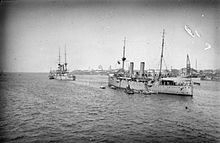HMS Fox (1893)
 HMS Fox
| |
| History | |
|---|---|
| Name | HMS Fox |
| Launched | 15 June 1893 |
| Commissioned | 1896 |
| Decommissioned | March 1919 |
| Fate | Sold for scrap 1920 |
| General characteristics | |
| Class and type | Astraea-class protected cruiser |
| Displacement | 4,360 tons loaded |
| Length | 320 ft (98 m) |
| Beam | 49 ft 6 in (15.09 m) |
| Draught | 19 ft (5.8 m) |
| Propulsion |
|
| Speed |
|
| Range | 7,000 nmi (13,000 km; 8,100 mi) |
| Armament |
|
| Armour |
|
HMS Fox was a second class protected cruiser of the Astraea class of the Royal Navy. The class represented an improvement on previous types, 1,000 tons displacement larger with better seaworthiness due to improved hull design. It also had somewhat increased firepower and superior arrangement of guns.
Construction[edit]

Ships of this category were designed for overseas duty where they were unlikely to encounter first class opposition. They were useful for showing the flag, suppressing piracy, escorting convoys during wartime, supporting colonial governments, and as a show of force to minor powers. They had some use in countering armed merchant cruisers of a hostile navy.
Fox was sheathed in wood and copper, to fit her for tropical waters. The hull of an unsheathed steel vessel operating in warm waters would usually become so encrusted with barnacles that its speed would be seriously affected within six months.[1]
Operational service[edit]

Fox was commissioned at Portsmouth on 10 September 1901 to relieve HMS Marathon on the East Indies Station,[2] and left home waters the following month after a commissioning trial in the Channel.[3] She arrived at Malta on 28 October,[4] at Aden on 11 November,[5] and later proceeded to Bombay. In early January 1902 she sailed to Kuwait, carrying six small guns presented by the British to Sheikh Mubarak, after recent trouble between Britain and Turkey in the Persian Gulf.[6] In September 1902 she was reported to be in Colombo, where she had escorted the SS Nithsdale after it had been involved in an accident near the Maldives,[7] and later that month she was back at station head quarters in Trincomalee.[8] In late December 1902 she paid a visit to the Persian city of Bandar Abbas, which had been damaged by an earthquake earlier in the year.[9]
In April 1904 Fox took part in the Somaliland Campaign, including supplying men for the landing party that stormed and captured the forts at Illig, the ship's guns supporting the attack.[10] She was paid off after six years in January 1907 and sent to the reserve fleet. In May 1908, she was recommissioned for the Home Fleet. In June 1908, she was sent once more to the East Indies where she served until 1914.
On the outbreak of the First World War Fox was 18 years old and obsolete, but continued in active service. Off Colombo, Ceylon, she captured two German merchant ships, the Australia on 10 August 1914, and the Holtenfels on 11 August 1914.
On 3 and 4 November Fox supported Indian and British troops in their unsuccessful attack on the port of Tanga in German East Africa on 3 and 4 November 1914. She then participated in the hunt for the German light cruiser SMS Königsberg and participated in a raid on Dar-es-Salaam where she bombarded the city. In January 1915 Fox was part of the force which occupied Mafia Island.
Fox served in the East Indies and Egypt from 1915 to 1917, and then in the Red Sea in 1917 to 1918. Fox played a critical role while in the Red Sea in supporting the Arab Revolt against the Ottoman Empire, flying the flag of William Boyle, 12th Earl of Cork.
In 1919, Fox was dispatched to participate as part of the British intervention in the Russian Civil War.
Scrapping[edit]
The ship was sold in 1920 and scrapped in Watchet Harbour, Somerset by the Cardiff Scrap and Salvage company, in the autumn of 1923. She is still the largest vessel ever to enter Watchet Harbour.
References[edit]
- ^ Copper sheathing, Globalsecurity.org
- ^ "Naval & Military intelligence". The Times. No. 36557. 11 September 1901. p. 8.
- ^ "Naval & Military intelligence". The Times. No. 36588. 17 October 1901. p. 4.
- ^ "Naval & Military intelligence". The Times. No. 36598. 29 October 1901. p. 8.
- ^ "Naval & Military intelligence". The Times. No. 36611. 13 November 1901. p. 11.
- ^ "Latest intelligence – The Persian Gulf". The Times. No. 36655. 3 January 1902. p. 3.
- ^ "Arrival of the Nithsdale". The Times. No. 36880. London. 23 September 1902. p. 4.
- ^ "Naval & Military intelligence". The Times. No. 36883. London. 26 September 1902. p. 8.
- ^ "Naval & Military intelligence". The Times. No. 36949. London. 12 December 1902. p. 8.
- ^ "The capture of the forts at Illig from the Mad Mullah, 21 April 1904", Paul G Lane. Orders & Medals Research Society Journal (Volume 59, number 2) June 2020. pp 152-156.
- Corbett, Julian S. (1920). History of the Great War: Naval Operations: Vol I: To the Battle of the Falklands December 1914. London: Longmans, Green and Co.
External links[edit]
- "Royal Navy Log Books of the World War 1 Era – HMS Fox". Retrieved 22 January 2012. Transcription of ship's logbooks November 1913 to April 1915
